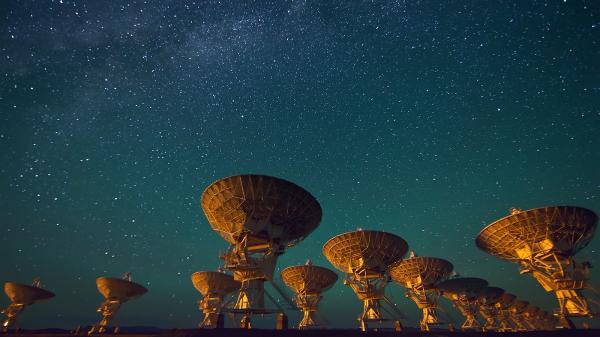What Is Universal Time?
Universal Time (UT) is a time standard that reflects the average speed of the Earth's rotation. It is not measured by clocks but by looking at the stars.

Radio telescopes are used to determine UT.
©bigstockphoto.com/hongee
Definition of Universal Time
Universal Time is a solar time standard that reflects the average speed of the Earth's rotation. Using the prime meridian at 0° longitude as a reference point, it shows the actual length of an average solar day on Earth, which is the time from one solar noon to the next.
When is solar noon in your city?
During a solar day, our planet completes a full rotation around its axis in relation to the Sun. Because of Earth's slowing rotation, a solar day is a little longer than 24 hours on average.
Earth sets new record for shortest day
UT Measured by the Stars
Despite being defined as a solar time standard, Universal Time is usually measured by the stars. This ensures a higher degree of accuracy.
As Earth spins around its axis, the Sun and other immobile celestial bodies appear to move across the sky. By registering the moment a fixed star passes a location's meridian (longitude) every day and comparing that observation with a super-consistent time standard like International Atomic Time (TAI), astronomers can determine the exact length of each solar day and, by extension, the precise speed of the Earth's rotation. Universal Time reflects the average duration of that time span.
Modern technology allows us to determine UT with an unprecedented level of accuracy. Procedures like Very Long Base Interferometry (VLBI), where an array of radio telescopes is used to intercept radio signals from distant celestial bodies, such as quasars, achieve a precision of less than 4 milliseconds in relation to TAI.
Sidereal Time vs. Solar Time
The time measured by the stars is called sidereal time. It is not the same as solar time, so scientists have to mathematically convert their measurements to arrive at UT. Sidereal time reflects the period it takes Earth to complete a full rotation around its axis in relation to a fixed object outside of Earth's orbit around the Sun.
Universal Time, on the other hand, refers to the time it takes Earth to complete a full rotation in relation to the Sun. Since the Earth revolves around the Sun, moving in the same direction as it spins around its axis, it has to rotate a little further each day to catch up with the Sun. This makes a solar day a little longer than a sidereal day—just under 4 minutes on average.
Planet Earth is an exceptionally accurate timekeeper
Versions: UT0, UT1, and UT2
Universal Time is issued in several variants, which deviate from one another by only a few milliseconds. Each version is used for different purposes.
UT0
UT0 is the version of Universal Time measured at a specific location. Since it does not take into account distorting factors like the constant movement of the Earth's poles (polar motion), it deviates from one location to another, making it a variant of Universal Time that, strictly speaking, is not quite universal. For this reason, it is rarely used.
UT1
UT1 is the most widely used type of Universal Time, and it is usually implied where times are stated simply as “UT.” It is a derivation of UT0 that takes into account polar motion.
Astronomers generally use this flavor of UT to time their observations. It is also one of the two fundaments of Coordinated Universal Time (UTC), the global time standard used to calculate local times worldwide. Earth's rotation slows down over time, so UT1 deviates increasingly from International Atomic Time (TAI), the second fundament of UTC, which is measured by highly precise atomic clocks. Before the difference between the UT1 and UTC reaches 0.9 seconds, a leap second is added to UTC, so our clocks reflect the speed of the Earth's rotation (UT1) as closely as possible. For this reason, while UTC and UT1 are not exactly the same, the difference between the two time standards is always less than a second.
As a time standard reflecting the mean solar time at the prime meridian in Greenwich, UK, UT1 is a successor of the original version of Greenwich Mean Time (GMT). Before UTC was introduced as the world time standard in 1972, GMT was a solar time standard that also acted as a reference point to determine local times worldwide. Today, GMT is a common time zone deriving its local time from UTC.
UT2
UT2 is a rarely used version of Universal Time that is adjusted to account for both polar motion and variations in Earth's rotation due to seasonal factors, such as changes in vegetation and water or snow distribution. From 1956 to 1972, UT2 was the international standard recommended for radio broadcasting.
Other Versions
Apart from these main strands of UT, there is a number of sub-types, such as UT1R and UT1D. These account for other factors affecting the speed of the Earth's rotation, such as the tides, but they are only used in few scientific contexts.
Other Time Scales Used for Astronomy
Astronomers use a variety of specialist time scales for calculating the position of celestial objects. These include Terrestrial Time (TT), which is 32.184 seconds ahead of TAI.